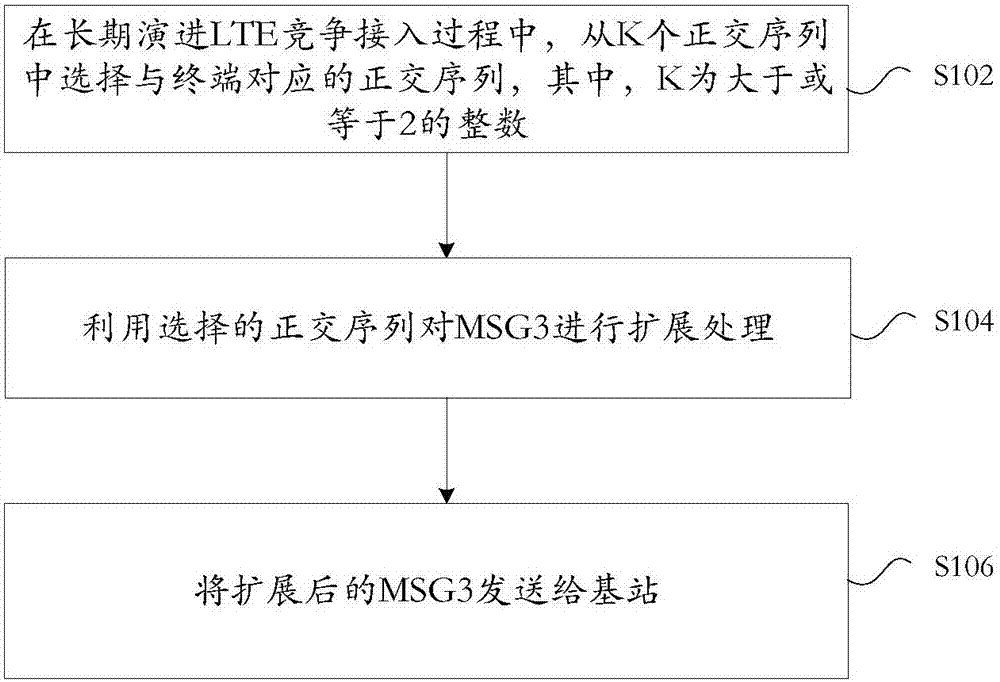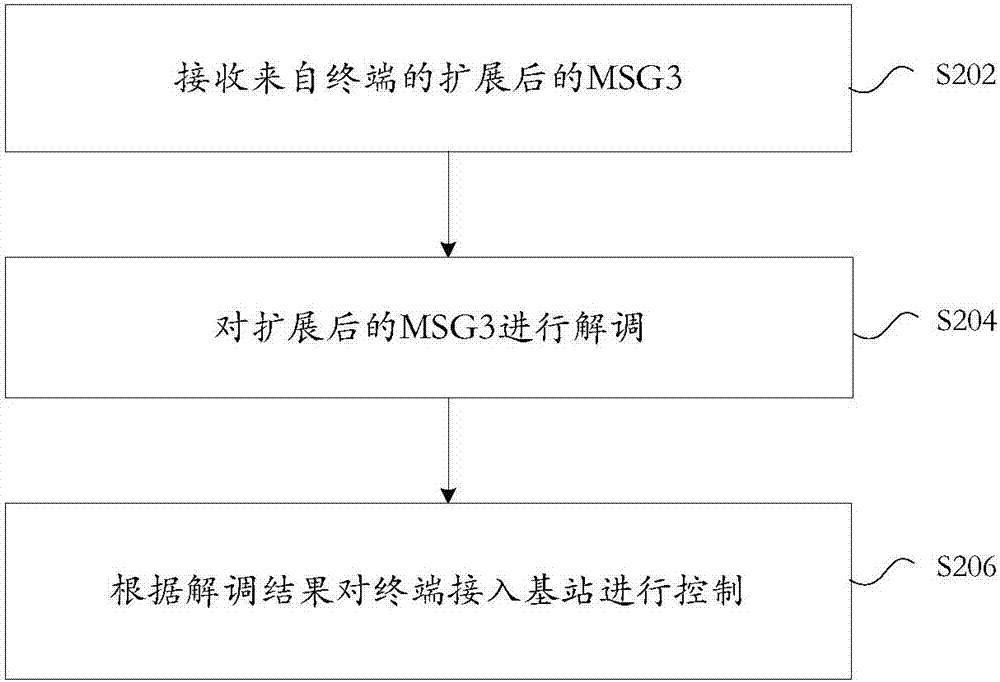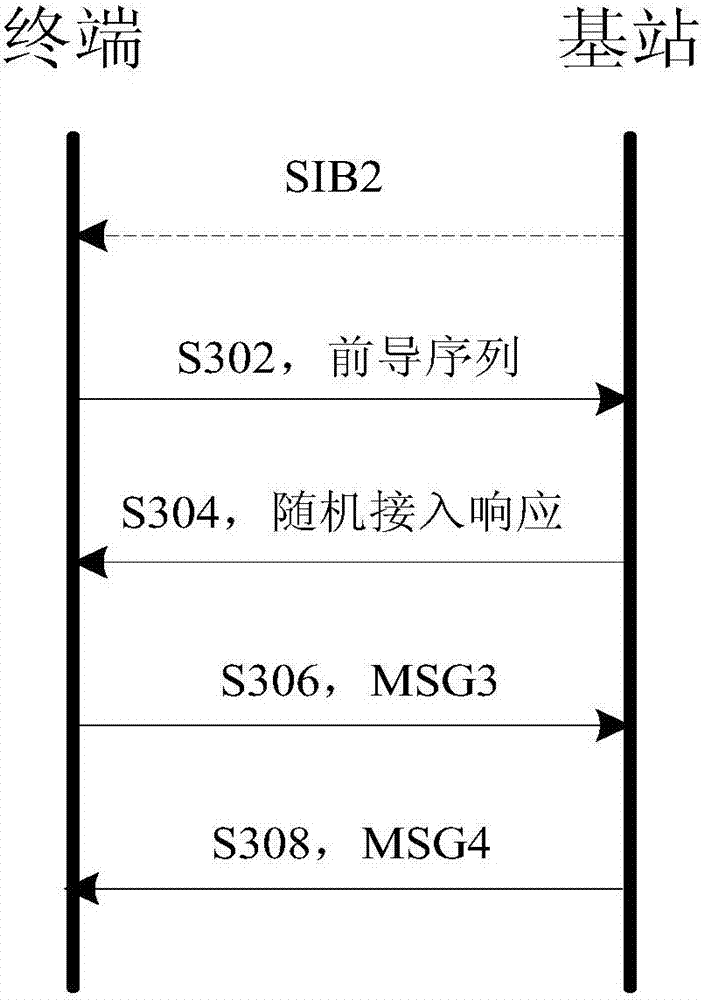Contention access method and device
A technology of competitive access and initial access, applied in the field of communication, can solve problems such as the inability to improve the ability of base stations to resolve conflicts, and achieve the effect of improving conflict resolution capabilities
- Summary
- Abstract
- Description
- Claims
- Application Information
AI Technical Summary
Problems solved by technology
Method used
Image
Examples
Embodiment 1
[0094] MSG3: The MSG3 data transmitted by the terminal for the first time can be successfully demodulated by the base station.
[0095] The terminal obtains TC-RNTI information from the received RAR data. In the initial random access technology of LTE, MSG3 is data containing UE ID and scrambled with TC-RNTI.
[0096] Suppose the signal S=[s 1 the s 2 the s 3 ... s n ] and K=[k 1 k 2 k 3 ...k m ] is the MSG3 data in LTE of two users scrambled with the same TC-RNTI, where n and m represent the number of symbols contained in one frame.
[0097] The sequence in the orthogonal sequence set adopts 4 long orthogonal sequences, such as the orthogonal sequence set:
[0098]
[0099] Suppose h i 、h j are the orthogonal sequences randomly selected by two users from H, then the improved MSG3 data are h i ×S, h j ×K.
[0100] Here it is assumed that the channel is ideal, then the data received by the base station side can be expressed as:
[0101] W=h i ×S+h j × K
[0...
Embodiment 2
[0109] MSG3: The MSG3 data previously transmitted by the terminal is not successfully demodulated by the base station, the terminal retransmits the MSG3 data, and each retransmission of each terminal uses the same orthogonal sequence for expansion.
[0110] Suppose the signal E=[e 1 e 2 e 3 ... e n ] and R=[r 1 r 2 r 3 ......r m ] are the MSG3 data of two users in LTE that need to be retransmitted and have the same TC-RNTI scrambling, where n and m represent the number of symbols contained in one frame.
[0111] The terminal uses the same orthogonal sequence as the previous transmission, instead of randomly selecting an orthogonal sequence from the set of orthogonal sequences. Assume that in the previous transmission, the orthogonal sequences used by the two users are h i and h j , then the improved MSG3 data are h i ×E, h j ×R.
[0112] Assuming that the channel is an ideal channel, then the data received by the base station can be expressed as:
[0113] U=h i ×...
Embodiment 3
[0128] MSG3: The MSG3 data previously transmitted by the terminal is not successfully demodulated by the base station, the terminal retransmits the MSG3 data, and each retransmission of each terminal is extended with a different orthogonal sequence.
[0129] Suppose the signal E=[e 1 e 2 e 3 ... e n ] and R=[r 1 r 2 r 3 ......r m ] are the MSG3 data of two users in LTE that need to be retransmitted and have the same TC-RNTI scrambling, where n and m represent the number of symbols contained in one frame.
[0130] The sequence in the orthogonal sequence set adopts 4 long orthogonal sequences, such as the orthogonal sequence set:
[0131]
[0132] The terminal randomly selects an orthogonal sequence from the orthogonal sequence set for each retransmission, that is, each user uses different orthogonal sequences for each retransmission.
[0133] Suppose the signal E=[e 1 e 2 e 3 ... e n ] and R=[r 1 r 2 r 3 ......r m ] are the MSG3 data of two users in LTE that ...
PUM
 Login to View More
Login to View More Abstract
Description
Claims
Application Information
 Login to View More
Login to View More - Generate Ideas
- Intellectual Property
- Life Sciences
- Materials
- Tech Scout
- Unparalleled Data Quality
- Higher Quality Content
- 60% Fewer Hallucinations
Browse by: Latest US Patents, China's latest patents, Technical Efficacy Thesaurus, Application Domain, Technology Topic, Popular Technical Reports.
© 2025 PatSnap. All rights reserved.Legal|Privacy policy|Modern Slavery Act Transparency Statement|Sitemap|About US| Contact US: help@patsnap.com



